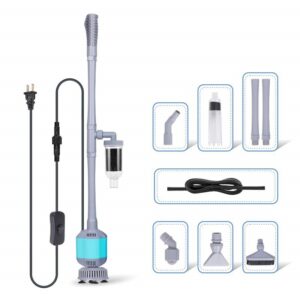Maintenance is an important part of keeping fish.
Content Table
Why fish tank maintenance is important?
- Without maintenance, the water will be contaminated with pollutants.
The accumulation of debris and other debris can endanger the health of the fish. Algae will soon cover a large area of the aquarium wall.
The function of the filter is not always sufficient, and the water in the aquarium needs to be replaced regularly. This equipment also needs regular maintenance to maintain the normal operation. Therefore, if there is no regular maintenance, the aquarium will soon become an unsuitable environment for fish to live in.
- Another reason for the maintenance is to ensure that you continue to enjoy your hobbies.
This may sound strange because maintenance is cumbersome, but without maintenance, you will not be able to see your precious pet fish, because the aquarium may be overgrown with algae. You don’t buy a new TV and let it be covered with dust, and you can’t see anything. The same situation applies to the aquarium, too.
Algae overgrowth is one of the main reasons why people give up fish keeping. Controlling algae and making our aquarium look great is something that every aquarium fish lover has been pursuing with great concentration.

How Often to Clean the Fish Tank?
Daily maintenance
- Check whether all the fish are alive and healthy and whether the number is correct. When you feed the fish every night, you can observe the fish.
- Check whether the filter, air pump, and heaters are connected to the power supply and whether they are operating normally.
- Remember to check whether the light is normally on within the specified time. In a very bright aquarium, wipe the glass with a magnetic brush to remove the growing algae.
- Feed the fish.
- If necessary, add plant liquid fertilizer every day.
Weekly maintenance
- Use a magnetic brush or scraper to clean the algae on the inner wall of the aquarium.
- Use a vacuum sand washer to remove debris, while partially changing the water.
- If necessary, clean the mechanical filter media with the old water in the aquarium, or replace it with new media.
- Test 4 main water quality parameters (pH, ammonia nitrogen, nitrite, and nitrate). If the nitrate is high, a large amount of water needs to be changed. When ammonia, nitrogen, or nitrite is present, check the cause immediately.
- If necessary, trim fast-growing plants.
- If necessary, add plant liquid fertilizer every week.
- Add water to compensate for the water consumed by evaporation.
Annual maintenance
- Replace the heater if necessary
- Check the filter and replace it if necessary
- Purchase new water quality testing reagents to ensure that the reagents are not out of date
- Check the number and size of fish in the aquarium and consider replacing it with a larger aquarium if necessary
- Give the aquarium a thorough cleaning, complete the water change, and even rebuild the scenery to keep the aquarium beautiful
5 basic tasks to keep fish
- Feed the fish.
- Remove the algae.
- Filter maintenance.
- Change the water.
- Water quality testing.
Comprehensive maintenance tasks
The best way to maintain is to carry out several tasks at the same time, which will get twice the result with half the effort, leaving more time to rest and enjoy the beauty of the aquarium. The best and fastest form of maintenance is to combine algae removal and sand washing, filter maintenance, and water change.
5 Aquarium Maintenance Steps
- Wipe the inner wall of the aquarium with an algae brush
- Use a sand vacuum cleaner to clean the bottom sand
- Then remove the water in the sand washer, store the water in a bucket, take out the medium after the filter is powered off, and use old water to clean it.
- Finally, discard the dirty water, put the medium back into the filter, and add tap water to the aquarium after chlorine has been removed.
These tasks can be completed in half an hour.
Bacterial culture can dissolve solid waste and improve water quality. Electrolytes and pH buffers can be added to the aquarium to maintain the hardness, alkalinity, and pH of the water body, thereby avoiding the collapse of the ecological balance of the water body.


Leave a comment